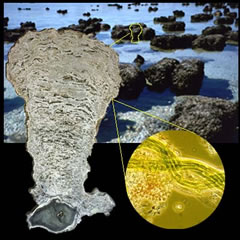Structure of stromatolites

Stromatolites grow slowly – layer upon layer – as mats of cyanobacteria grow atop older layers. Because this process still occurs today, paleontologists were able to determine the origin of carbonaceous material in fossilized laminated domes found widely around the globe.
Bacterial photosynthesis depletes carbon dioxide in the surrounding water, initiating precipitation of calcium carbonate. Layers of CaCO3 precipitate over the growing mat of bacterial filaments. This mineral, together with grains of sediment precipitating from the water, is trapped within a sticky layer of mucilage that surrounds the bacterial colonies. The cyanobacteria continued to grow upwards through this sediment to form a new layer. As this process occurs over and over again, layers of sediment are created.
Hamelin Pool in Shark Bay in western Australia is well known for the stromatolite "turfs" rising along its beaches. Meter-high stromatolites in the northern Bahamas are alternately buried and exhumed by carbonate sand bodies in an area of active bedform migration. Marooned Mexican stromatolites in Poza Azul lake at Cuatro Cienegas, Mexico, are of interest to NASA scientists who believe that these calcified clumps of primitive bacteria lurking in cactus-ringed lagoons could provide important clues in their search for extraterrestrial life. Images: diagram of stromatolites in dolomite block / fossil showing columnar structure / cylindrical structure / fossil showing striations / diagram of stromatolite morphology / stromatolite types /








































